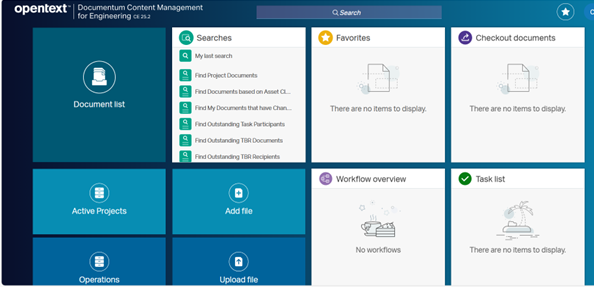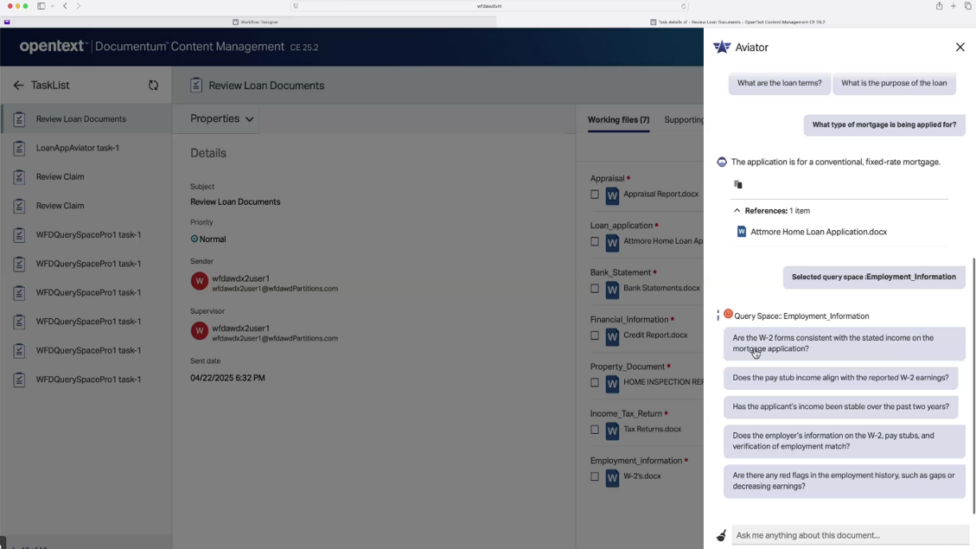In the energy, manufacturing, and construction industries, managing vast amounts of technical documentation, ensuring compliance, and optimizing workflows are critical to maintaining operational efficiency and safety. OpenText™ Documentum™ Content Management (CM) and OpenText™ Documentum™ Content Management (CM) for Engineering have long been a trusted enterprise content management (ECM) platform for these sectors, offering robust document management, security, and scalability. Now, OpenText Documentum CM for Engineering is revolutionizing how these industries handle complex processes with the integration of generative AI capabilities through OpenText™ Content Aviator and the new AI-driven workflow insights. Let’s explore how these AI features can supercharge your operations, with specific use cases tailored to energy, manufacturing, and asset operations.
OpenText Documentum CM for Engineering: A foundation for energy, manufacturing, and construction
OpenText Documentum CM for Engineering provides a cloud-native content management platform that excels in managing technical documentation, such as engineering drawings, condition reports (CRs), and technical evaluations (TEs), while ensuring compliance with industry regulations. Its granular security, encryption, and audit trails safeguard sensitive data and manages massive data volumes securely. Its scalability—handling billions of documents— and cloud flexibility (SaaS, PaaS, IaaS, hybrid), make it ideal for global operations.

OpenText Content Aviator: AI-powered insights for faster decision-making
OpenText Content Aviator brings generative AI to OpenText Documentum CM and OpenText Documentum CM for Engineering, enabling conversational search, summarization, content generation, and multilingual translation. The seamless integration ensures all interactions adhere to strict security and privacy controls—data is encrypted, and responses are generated only from content users are authorized to access. This is particularly valuable in regulated industries like energy and manufacturing, where compliance is non-negotiable.

AI-driven workflow insights: Smarter processes at every step
The new AI-driven workflow insights powered by OpenText Content Aviator embeds AI into OpenText Documentum CM’s workflow engine, analyzing content at each step and presenting key data points to reviewers. This streamlines decision-making by reducing manual analysis, ensuring faster and more informed actions. OpenText Documentum CM’s workflow capabilities already offer a no-code/low-code environment with pre-built templates and features like task escalation and real-time monitoring which increased document processing by 3.5x. Now, AI enhances these workflows, making them even more efficient.
Specific use cases for energy, manufacturing, and construction
Impact review: Pinpointing affected documentation and equipment
OpenText Content Aviator can analyze updates or changes (e.g., new safety regulations or equipment upgrades) and pinpoint documentation and equipment that may be impacted. For example, in a manufacturing plant, if a new regulation affects a specific machine component, OpenText Content Aviator can identify all related drawings, procedures, and maintenance records in OpenText Documentum CM, presenting a summary to the reviewer. In an AI-driven workflow, this analysis happens at each step, ensuring that maintenance teams are immediately aware of impacted assets, reducing downtime and ensuring compliance.

Visualization and reporting: Streamlined data in table formats
OpenText Content Aviator’s visualization and reporting capabilities allow users to generate results in table formats, which can be copied or downloaded into Excel for quick list generation. At operational facilities, a maintenance manager can query OpenText Documentum CM for a list of all equipment due for inspection, and OpenText Content Aviator will present the results in a table, including asset IDs, locations, and last inspection dates. This table can be exported to Excel, enabling rapid report generation for audits or team briefings, saving hours of manual compilation.
AI agents: Multisystem task automation with Maximo integration
Energy and manufacturing industries are extremely interested in having OpenText Content Aviator talk with other agents to complete complex, multisystem tasks, such as opening Work Orders in Maximo. For instance, during a maintenance workflow in OpenText Documentum CM for Engineering, Content Aviator can identify a need for a Work Order based on a condition report, communicate with Maximo to open the order, and update the workflow with the Work Order ID—all without manual intervention. This seamless integration reduces delays, ensuring that maintenance tasks are initiated promptly and tracked efficiently.
Condition Reports (CR): Trending and summarization
OpenText Content Aviator can evaluate Condition Reports (CRs) by trending data, pointing out references, summarizing actions taken, and highlighting other key items. In an energy plant, a safety officer can ask, “What trends are emerging from recent CRs?” OpenText Content Aviator will analyze CRs stored in OpenText Documentum CM, identify patterns (e.g., recurring equipment failures), and summarize actions taken, such as repairs or procedural updates. In an AI-driven workflow, these insights are presented at each review step, helping safety teams make data-driven decisions to mitigate risks.
Engineering: Finding untagged drawings with CAD tools
OpenText Content Aviator assists engineering teams by finding drawings that have certain parts or references not tagged in modern CAD tools. For example, in a manufacturing facility, an engineer can query OpenText Documentum CM for drawings containing a specific pump model that lacks proper tagging. OpenText Content Aviator will search the repository, identify relevant drawings, and summarize their content, highlighting untagged references. In an AI-driven workflow, this analysis can trigger a review step, ensuring that engineering teams update drawings to meet current standards, improving asset traceability.
Procedures: Summarizing and guiding tasks
OpenText Content Aviator excels at getting procedure summaries and answering how-to questions based on procedures, such as dispositioning a CR or performing maintenance tasks. In an energy plant, a technician can ask, “How do I disposition a CR for a turbine failure?” OpenText Content Aviator will summarize the relevant procedure in OpenText Documentum CM, providing step-by-step guidance. In an AI-driven workflow, this summary is presented at the disposition step, ensuring the technician follows the correct process, reducing errors and ensuring compliance with safety protocols.
Technical Evaluations (TE): Querying status and results
OpenText Content Aviator can answer general queries around Technical Evaluations (TEs), such as “Is a TE closed?” or “What were the results of the TE?” In asset operations, a reliability engineer can ask, “What was the outcome of the TE on our compressor system?” OpenText Content Aviator will search OpenText Documentum CM, confirm the TE’s status (e.g., closed), and summarize its findings, such as recommended maintenance actions. In an AI-driven workflow, this information is provided at the review step, enabling engineers to make informed decisions about asset maintenance without manual searching.
Fault tree analysis: Explaining and discussing fault trees
OpenText Content Aviator can assist with Fault Tree Analysis by analyzing, explaining, and discussing fault trees stored in OpenText Documentum CM. For example, in an energy plant, a risk analyst can ask, “Explain the fault tree for our power grid failure.” OpenText Content Aviator will break down the fault tree, highlighting key failure points and their probabilities, and provide a conversational explanation. In an AI-driven workflow, this analysis can be presented during a risk assessment step, helping teams understand potential failure modes and prioritize mitigation strategies.
Conclusion: Empowering energy, manufacturing, and construction with AI
OpenText Documentum Content Management for Engineering, enhanced with OpenText Content Aviator and the new AI-driven workflow, offers transformative generative AI capabilities for the energy, manufacturing, and asset operations industries. From pinpointing impacted documentation during an impact review to automating Work Orders in Maximo, summarizing CRs, and explaining fault trees, these AI features streamline processes, enhance decision-making, and ensure compliance. OpenText Documentum Content Management’s robust security, scalability, and integrations—combined with AI-driven workflow insights—make it an ideal solution for managing complex technical content.
Ready to see AI content management in action? Take OpenText Content Aviator for a test drive today and see firsthand how AI-driven workflow insights can unlock your organization’s potential.
Try OpenText Content Aviator



